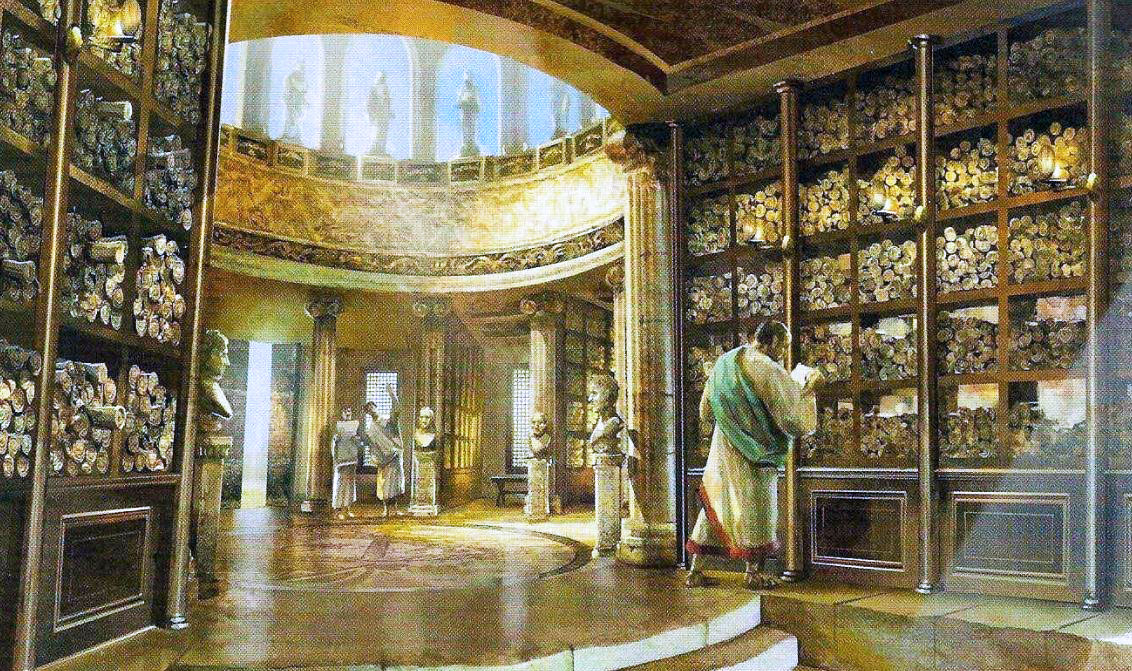By Frank J. Korn
The Via Argiletum was a heavily trafficked street in Imperial Rome that led down from the slums of the Subura district and entered the Forum Romanum between the Senate House and the Basilica Aemilia. Along that road, one could daily encounter a microcosm of the city’s populace.
Back in the days of ancient Rome, you might stake out a shady sidewalk spot and watch the ceaseless river of changing faces as the flowed by. In the eclectic there would be actors, bankers, businessmen, teachers and teenagers, as well as ladies of the social register, pickpockets and down-and-outers. Their one common denominator: A passion for good books.
The Argiletum, you see, was Rome’s equivalent and precursor to Paternoster Row or Park Avenue; in other words, it was the center of the publishing and bookselling trade. Many publishers not only had their offices along this clamorous paved thoroughfare, but their factories and retail outlets were located there as well. It was also a rendezvous for the distinguished literati of the day, who would be on hand to help promote sales of their latest volumes.
Up until the last half-century before Christ, the publishing business was virtually non-existent. There were no public libraries and the literacy rate was woefully low.
One writer of the time however, Marcus Tullius Cicero, had the advantage of a wealthy friend, Atticus, who put his skilled slaves to work mass-producing editions of Cicero’s manuscripts. When Atticus noted the ever-increasing market of book-lovers, this astute financier jumped into the publishing business. He soon entered into agreements with a number of aspiring writers. Naturally, Cicero headed his list of authors.
Atticus’ production plant on the Argiletum had one room where slaves pressed the fine bark of the Egyptian papyrus into sheets and another where they glued the edges of these pages together to form very long sheets. In a third room, dozens of slaves skillful in penmanship sat at drafting tables and wrote on these long sheets with reed pens, using ink made from lampblack, while a reader dictated from the original manuscript.
By 39 B.C., the literacy rate had improved significantly, C. Asinus Pollio founded a for-profit lending library on the Aventine Hill. With the increased demand for books, the early publishing industry began to flourish. Shops blossomed on the Argiletum. Julius Caesar had plans in the works to build the first State Library, following his assassination, Augustus completed the project.
Libraries opened in provinces and municipalities throughout the Empire. By the end of the first century A.D., there were numerous libraries in Rome itself, the most impressive of which the twin libraries built by Trajan, one with works written in Latin, the other written in Greek.
Publishing houses soon dominated the Argiletum. The authors Quintilian and Martial (first century A.D.) both mention the firms of Tryphon and Atretus. There are also references to the publishing firms of Dorus and Q. Pollius Valerianus. While the idea of royalties was still unknown, the publisher and author surely must have reached some form of profit-sharing arrangement.
A publisher would try to estimate the demand for a new manuscript have copyists produce the work. No copy would leave the establishment until the whole edition was ready.
By the mid-second century, dealers were shipping their neatly packaged products to all corners of the Roman realm. Stores and stalls hung advertisements giving the prices of new releases, sometimes excerpts would be posted to generate excitement. Literacy clubs and discussion groups soon became commonplace – as had the expression, “What’s new on the Argiletum?” It was the golden age of Roman publishing.
Today there is hardly a trace of the colorful old book bazaar. It courses somewhere beneath 18th century buildings and Mussolini’s Via dei Fori Imperiali. The short stretch of the Via Argiletum that penetrated the Forum Romanum is now overrun with weeds and broken masonry and far from hosting literati, is instead the home to a colony of vagrant cats.
Frank J. Korn is the author of nine books on Rome and a Fulbright Scholar at the American Academy in Rome.




